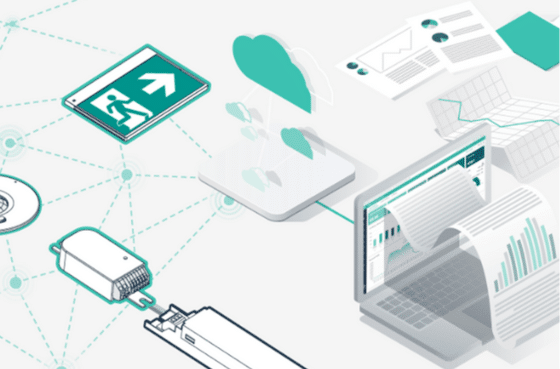How Can Workplaces Compete with “Working From Home”?
 With New Zealand currently operating at “Red” under the COVID-19 traffic light system and as we wait for Omicron to take hold, causing the issues with staffing and supply that we’ve seen overseas, many companies appear to be operating a hybrid working model.
With New Zealand currently operating at “Red” under the COVID-19 traffic light system and as we wait for Omicron to take hold, causing the issues with staffing and supply that we’ve seen overseas, many companies appear to be operating a hybrid working model.
In some cases, particularly in manufacturing and logistics, this may involve staff working “shifts” with no interaction between the different teams occupying premises at different times. In others “essential staff” may be working from work premises, with others still working from home where possible, or there may be certain days staff attend the office, and they work at home on others.
What is clear is that many of us have become accustomed to “working from home” and as we anticipate a return to business premises after the peak of Omicron has passed, we have become accustomed to the advantages working from home provides and have raised our expectations as to what we believe our working environments should provide.
If employers want their staff to be equally happy and productive in their business premises, as they are at home, then it may be time to look at the workspaces they provide.
Is it too much to expect that the buildings in which we work should safeguard workers’ health and welfare, and provide a comfortable environment that is equal to what we experience at home?
IoT building technology can assist in meeting your staff’s expectations of their workplace.
USE OF SPACE
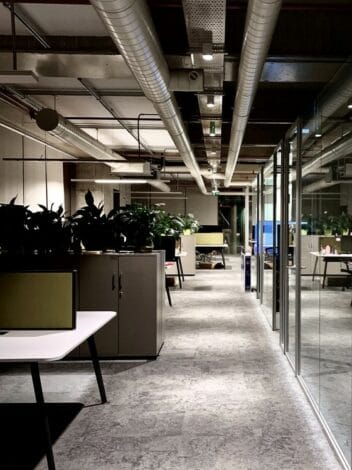 As companies adapt to more flexible working policies with teams or departments operating at different times, or staff working from home some of the time, “hot desking” will likely become more popular, with staff working at any “available” desk or workspace, rather than having a dedicated area.
As companies adapt to more flexible working policies with teams or departments operating at different times, or staff working from home some of the time, “hot desking” will likely become more popular, with staff working at any “available” desk or workspace, rather than having a dedicated area.
Without a doubt, as commercial leases expire, we will likely see businesses responding to this new way of working, (with the added incentive of saving costs), by reducing the size of their real estate. This is less about “squeezing desks together” and more about the introduction of rosters/schedules to determine when certain staff members will be on-site together.
Planning and monitoring such arrangements will become an important element for every manager, who will need to ensure capacity is sufficient to meet the demand from employees.
IoT building technology can provide reliable, cost-effective data, providing ‘live’ information, as well as historic “trends”. Analysis of this data will provide management with clarity around occupancy levels and fluctuation in usage will be invaluable when planning how real estate should best be utilised.
In addition, if you want your workers to be equally happy and productive at work, as they are working from home, an investment in upgrading your business premises with some smart technology, could be well worthwhile.
Meeting Rooms
Frustrations can occur when employees have come to work specifically to attend business meetings and then discover a meeting space is not available.
When a meeting is pre-planned there is usually no issue with the easy availability of room booking software. The frustration is usually when the meeting is more ad-hoc and a “free” location cannot be identified, then later it’s discovered that a room reserved for two hours, was actually vacated an hour earlier!
Technology again provides a simple solution. Occupancy sensors can provide feedback to show a room is unoccupied, even when the room booking system would indicate otherwise.
HEALTH AND WELLBEING
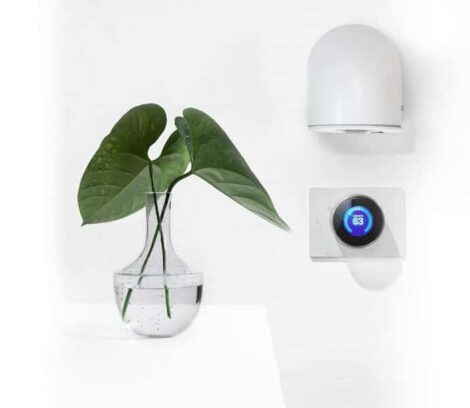 A healthy and comfortable environment in the workplace should be a given, just as you would expect at home. IoT technology can certainly assist with ensuring your facility is operating to its optimum in terms of the level of comfort the building can provide, and also monitor and report on any issues to ensure the health and safety of your staff remain paramount.
A healthy and comfortable environment in the workplace should be a given, just as you would expect at home. IoT technology can certainly assist with ensuring your facility is operating to its optimum in terms of the level of comfort the building can provide, and also monitor and report on any issues to ensure the health and safety of your staff remain paramount.
Smart sensors can monitor eCO2, temperature, eVoCs, humidity, sounds and pressure, as well as occupancy and light levels, so can be used to ensure optimal building performance.
Data provided by sensors can feed back to analytics software providing visualisation and reporting on your facility. This information can provide user-friendly identification of how your building is being utilised. Which restrooms are used more often, and therefore require servicing more frequently? Which desks are more popular, which are last to be occupied? How does the air quality compare first thing in the morning, to mid-afternoon when staff are yawning? Likewise, what is the humidity level? The temperature? Your reporting system can also advise the facility manager of lamp failures, compliance issues with emergency lighting, and other maintenance matters so they can be dealt with quickly and efficiently, with minimal inconvenience to staff.
Human Centric Lighting
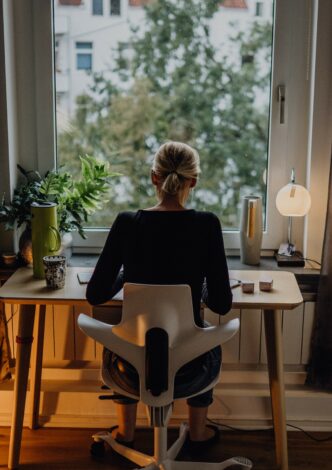 When working from home, you are likely more in touch with the outdoors, often sitting near an opening window, able to walk outside for a break, etc. Our bodies work best when we are exposed to the natural rhythm of day and night. The light in the early morning wakes us up, and invigorates us, then changes gradually during the day until dusk, allowing our bodies to enter a more restful state for sleep.
When working from home, you are likely more in touch with the outdoors, often sitting near an opening window, able to walk outside for a break, etc. Our bodies work best when we are exposed to the natural rhythm of day and night. The light in the early morning wakes us up, and invigorates us, then changes gradually during the day until dusk, allowing our bodies to enter a more restful state for sleep.
Lighting control technology in the workplace can create circadian curves to transition light colour and intensity through the day (and night if required for shift workers) which allows our bodies to respond to light in the same way as when at home.
In addition to biological or circadian lighting, (designed to support the sleep-wake cycle), lighting can also be used to create an environment that is perceived emotionally as comfortable and safe.
This can be achieved with a zencontrol system by adding full colour tuning to your building, not just tuneable white, but tuneable colour!
When working at home, if better light is required for a particular task, we just move to a different location. In the workplace, it’s important to provide functional lighting to prevent user discomfort and facilitate concentration and creativity. The intensity of light required differs between workers and tasks. Lighting control technology can provide the ability for staff members to control the light above their desk individually, to suit their needs at any specific time. zencontrol provides such individualised control via an app each user can install on their smartphone.
ENERGY SAVING EXPECTATIONS
New Zealanders are very aware of climate change, and the need for the planet to make changes quickly around the way we use energy.
At home, most of us carefully switch off electrical equipment when it’s not required, and have invested in ways to schedule heating, towel rails etc to avoid unnecessary use of power. If employees (and customers) see wasteful use of energy in the workplace they become frustrated and disillusioned.
IoT technology helps a business become more energy aware and guides it towards a more energy-sustainable path.
Even for an existing building, it is relatively simple to upgrade to smart lighting with occupancy detection, thus ensuring lights are turned off when a room or area is unoccupied.
Using smart sensors and analytics software (as mentioned earlier) potential inefficiencies in a building can be identified. It may be that heating, ventilation or air-conditioning equipment is either generating too much heat or too much cooling. Or perhaps indicates where heat loss is occurring due to poor insulation.
CONCLUSION
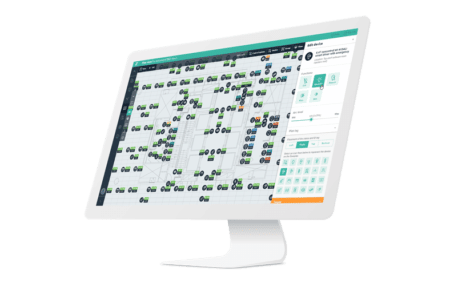 With hybrid working becoming the 2022 norm, there is already an increased level of expectation from employees concerning the services and types of facilities they want and need in the workplace. A “home from home” is what many staff would like to experience, with comfort, wellbeing, and energy awareness being at the top of their requirements.
With hybrid working becoming the 2022 norm, there is already an increased level of expectation from employees concerning the services and types of facilities they want and need in the workplace. A “home from home” is what many staff would like to experience, with comfort, wellbeing, and energy awareness being at the top of their requirements.
Evolving evidence ensures we understand more about the physical environment’s impact on human wellbeing than ever before. Technology allows us to create spaces that enhance (rather than hinder) our peoples’ health. The ability to measure (and then improve) the quality of light, air, temperature etc in our buildings means we can design environments that fuel our minds, keep us connected, inspire our best work and facilitate a good night’s sleep.
Why shouldn’t our workspace become our “home from home”.
If you are looking at making some smart changes to your workplace, give us a call! Happy to chat about possibilities and options.

